Support the SOAS Cleaners
Home Office, Tues 30 June, 2009
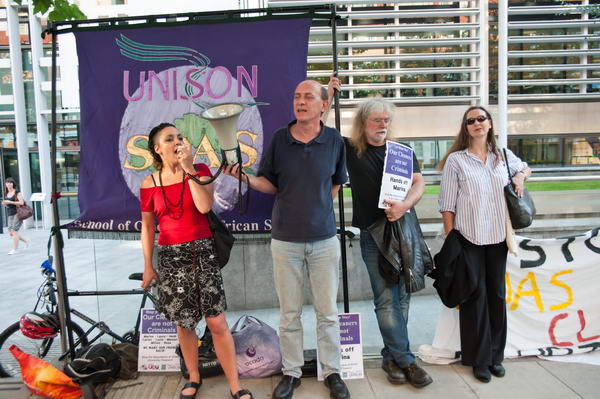
Trades Unions, staff and students at the SOAS all support the cleaners
more pictures
A demonstration outside the Home Office in Marsham St called for an end to
the hounding of migrant workers by the Borders Police and for the release
of Marina Silva, the SOAS cleaner still held in Yarl's Wood, as well as the
return of those already forcibly deported.
The demonstration, called by trade unions and students from SOAS, made clear
the opposition of all to the heavy-handed action of the Borders Police, and
to the denial of justice to those seized in raids such as the one at the SOAS.
The Borders Police were called in by cleaning contractors ISS to a 6.30am
staff meeting, but similar eraly morning raids, with refusal of trade union
or legal representation, take place in homes around the country.
The action of ISS was essentially directed not against individual cleaners
but as a reprisal against all the staff they employ who have stood up for
their rights through union organisation and in particular the London living
wage campaign. The unions and students at SOAS have called for cleaning to
be taken back in-house and for a policy of non-cooperation between university
management and immigration police.
The demonstration, attended by well over 50 people, including some of the
remaining cleaners, was addressed by a number of representatives, and was
able to talk to someone inside Yarl's Wood close to Marina on a mobile phone.
Efforts continue to secure the release of those still in this country, as
well as to get exceptional leave to remain for those already deported.
more pictures
Defeat the Honduras Coup!
Honduras Embassy, London. Tues 30 June, 2009
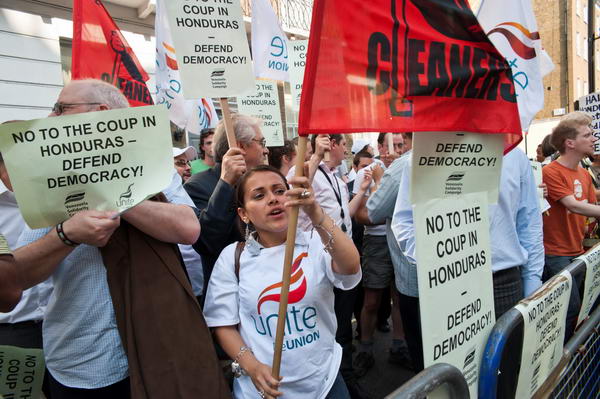
Demonstration opposite the Honduras embassy says NO to the coup!
more pictures
rotesters gathered outside the Honduran Embassy in Gloucester Place, London
on Tuesday evening (30 June 2009) in an emergency picket against the reactionary
military coup in Honduras on Sunday 28 June.
Manuel Zelaya, popularly known as 'Mel,' won the 2005 presidential
elections for the Liberal Party, but in office began to pursue progressive
policies which favoured the poor majority of the citizens, losing the support
of the centre right but gaining the backing of peasant and workers organisations.
His policies began to break the control of the oligarchic ruling class and
mainly US multinationals, siding with the Bolivarian Alternative of the Americas
(ALBA), a regional alliance led by Venezuela.
Honduras in the last century was a classic "banana republic", quite
literally so with the US giant United Fruit controlling most prime agricultural
land and essentially running the country.
200 soldiers surrounded the President's residence on Sunday, and after a
short gun battle he was arrested and deported to Costa Rica. Leading generals
in the coup were trained by the US in a CIA run facility, although their present
activities may not be supported by the current US administration. President
Zelaya denounced the military coup as the work of "right-wing oligarchs"
and issued a call for the people to mobilise on the streets, pledging to return
to his country.
Protesters in London called for an end to the coup and a return to democracy
in Honduras at an emergency picket called by Co-ordinadora Latinoamericana
(Hands Off Venezuela, Bolivia Solidarity Campaign, Colombia Solidarity Campaign,
Ecuadorian Movement in the UK, Latin American Workers Association and Polo
Democratico UK) and supported by Colectivo Acuerdo Humanitario. They
included many with Unite banners and campaigners from 'Cleaners for Justice'.
more pictures
Plumstead & Woolwich
Plumstead, Thamesmead West, River Thames, 28 June, 2009
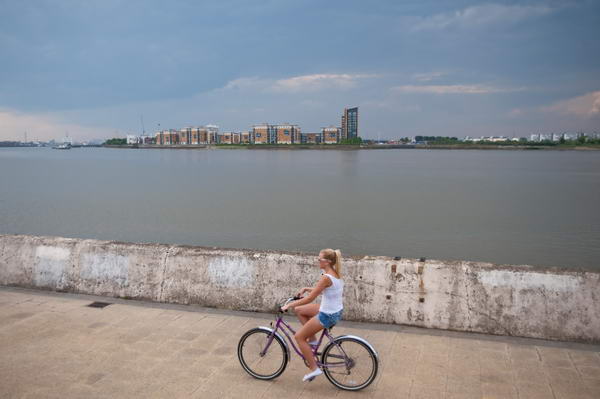
Thames Path at Thamesmead.
more pictures
I started at the Mela on Plumstead Common, now in its 19th year, but it was
a bit early for much to be happening, and I decided instead to walk back down
the hill into Plumstead and then go through Thamesmead and along the Thames
path.
Plumstead has a clear case for feeling maligned in 'The Buildings of
England' (unless later editions than 1983 London 2 South on
my bookshelves have altered its views.) Pevsner didn't much care for Victorian
or Edwardian architecture, and certainly not for its more vernacular aspects.
My pictures here don't give much impression of it either, but it's worth a
walk around from several aspects, although the heat today made going up the
hill very tiring work, so I didn't wander around as much as I otherwise might.
Most of the walk was interesting, although Thamesmead West was depressing,
with Braodwater a stagnant mess and the architecture a tedious failure. Everytime
I see it I think how much more could have been made of this fomer Ordnance
Canal, built by prisoners from the Napoleonic wars to carry explosive materials
from the Woolwich Arsenal site to the Thames for enshipment. There is still
no walkway around part of the west side, with what was once meant to be part
of Gallions Park fenced off, overgrown and undeveloped. The path along its
east bank is almost entirely overlooked by the disappointing backs of the
houses along Whinchat Rd, and it gives the impression that the developers
ran out of both money and ideas.
Perhaps the most obvious way to improve this would be to re-open the lock
to the Thames and to create a small marina with more and better public open
space around it - difficult indeed to see why something better was not done
in the first place.
My timing was good; we had been promised thunderstorms and as I made my way
out of the Woolwich Arsental site and across Woolwich Market to the station
a few large drops marked their start, and once I was on the train the heavens
really opened. But the unusual lighting and clear air before the storm did
give some interesting distant views along the Thames.
more pictures
Sri Jagannatha Rathayatra Festival
Hyde Park to Traflagar Square. Sun 28 June, 2009
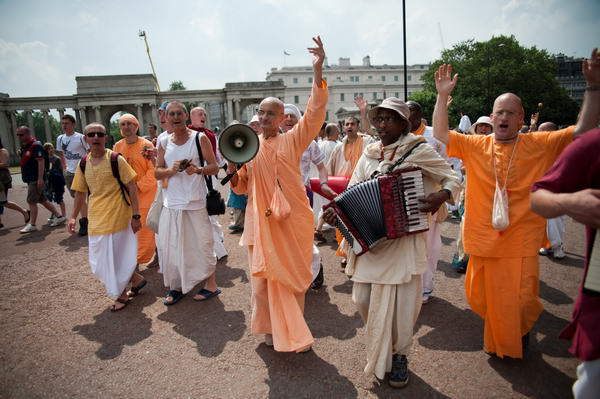
Musicians in the procession as it leaves Hyde Park
more pictures
This was the 41st annual chariot festival in London since the Hare Krishna
started to celebrate it here in 1967 and there were only minor differences
to those I've seen in recent years. The Sri Jagannatha Rathayatra festival
is of course much older (5000 years according to the Hare Krishna) and now
takes place in over 200 cities around the world. You can read more about it
in my post on last
year's festival.
The large chariots - we got the word "juggernaut" from this festival
- pulled by hundreds on long ropes from Hyde Park to Trafalgar Square carry
the Lord Jagannatha (Krishna), Lord Balaram and Lady Subhadra and are accompanied
by singing and dancing crowds. The celebrations continue in Trafalgar Square,
where I called in briefly having left the procession coming down Piccadilly.
more pictures
Support Migrants - Fight Racist Immigration Laws
Old St, London. Sat 27 June, 2009
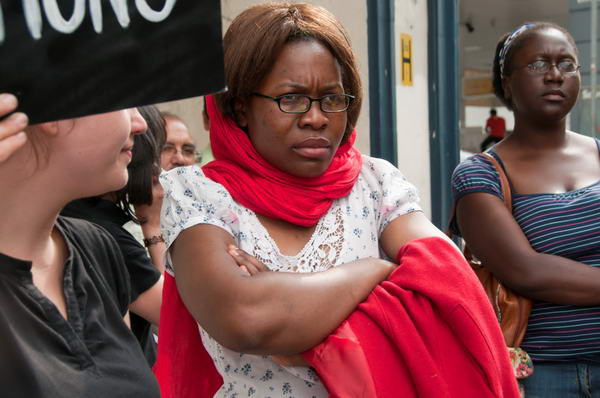 Laureine
Tcuapo, recently released from Yarl's Wood, spoke at the demonstration
Laureine
Tcuapo, recently released from Yarl's Wood, spoke at the demonstration
more pictures
Seventy people demonstrated outside Communications House in London on Saturday
afternoon (27 June 2009) in a protest organised by the Campaign Against
Immigration Controls in support of the SOAS cleaners who were
detained there, the protesters at Yarls Wood and all migrants in struggle
against Britain's racist immigration laws.
Communications House is an Immigration Reporting Centre on Old Street, to
the north of the City of London, and is a gateway though which many refugees
and asylum seekers are processed before being taken to detention centres and
deportation. It was where the SOAS 9, cleaning workers at a London college,
were taken after an early morning raid alleged to be a reprisal against their
succesful campaign for a living wage and trade union recognition, and campaigners
for them were among those there today.
protest began with an address by Laureine Tcuapo (wearing a red
scarf), who fled to Britain to escape repeated rape and abuse from a relative
in the Cameroon police force. On Friday 12 June at 7am, immigration police
kicked down the door of her Newcastle house and took her and her two young
children forcibly to Yarl's Wood Immigration Detention. After campaigning
on her behalf by Tyneside Community Action for Refugees and No Borders North
East on her behalf she was not flown back to Cameroon as planned, and was
released from detention on 25 June but is still at risk of deportation.
Laureine was in Yarl's Wood when the continuing hunger strike by detainees
began last Monday, in protest over the inhumane conditions there. Yarl's Wood
is effrectively a prison privately run by SERCO. Earlier, in a press release
from TCAR she had said "Families were separated; people were being
beaten up by guards. It just felt to all the asylum seekers that we were less
than animals... I still think about my time in Yarlswood. It was very traumatising.
I can’t even imagine how things are at the moment for people inside.
They’re counting on us because inside, they have no rights."
We also heard, over moblie phones, directly from those still held at Yarl's
Wood. Much of what is still happening at places such as Yarls Wood has been
condemned by official inspections and is clearly against the laws of this
country as well as EU Human Rights leglislation and attention needs to be
drawn to it. Our treatment of migrants, especially asylum seekers offends
against justice and humanity.
more pictures
Shoreditch
Shoreditch, London. Sat 27 June, 2009
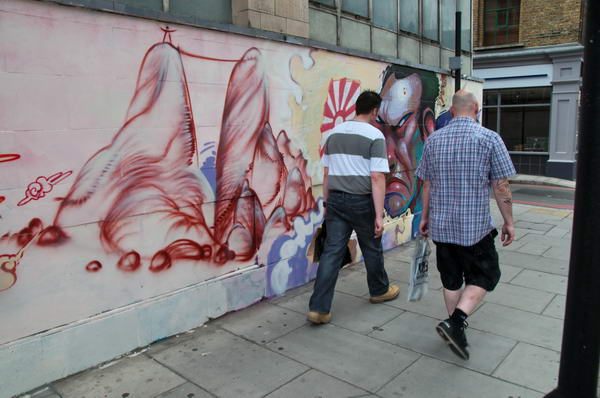
Shoreditch street
more pictures
I was a little early for the demonstration at Old St, so I decided to walk
there from Liverpool St station, where my train from Stratford teminated.
Over the past 20 or so years, Shoreditch has changed from a run-down area
of warehouses and small workshops being taken over by artists for cheap studios
to one of the trendier areas of London, and its graffitt capital.
more pictures
Olympic Update II
Stratford, London. Sat 27 June, 2009
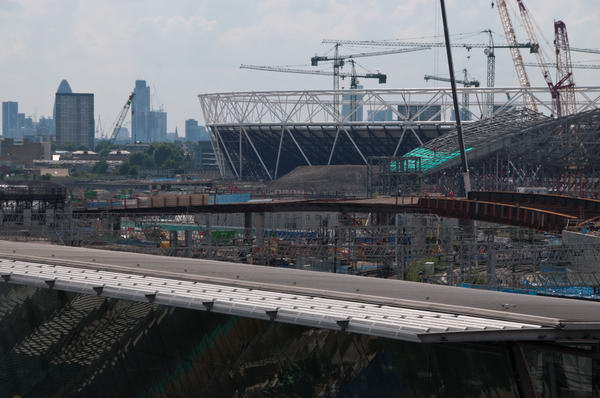 The
Olympic stadium from Stratford town centre
The
Olympic stadium from Stratford town centre
more pictures
I was in Stratford for a meeting on Saturday and took the opportunity to
take a few pictures of the Olympic site from a high viewpoint. In the foreground
is Stratford Station (and in some pictures the bus station and square) and
as well as the Olympic stdium and aquatic centre there are also the buildings
for a new shopping centre being built by Westfield. The large bridges in some
pictures are for the pedestrian ways into and across the site. The viewpoint
is almost exactly 1km from the stadium.
more pictures
Kew Bridge Eco-Village
Kew Bridge, Brentford, London. Sunday 21 June, 2009
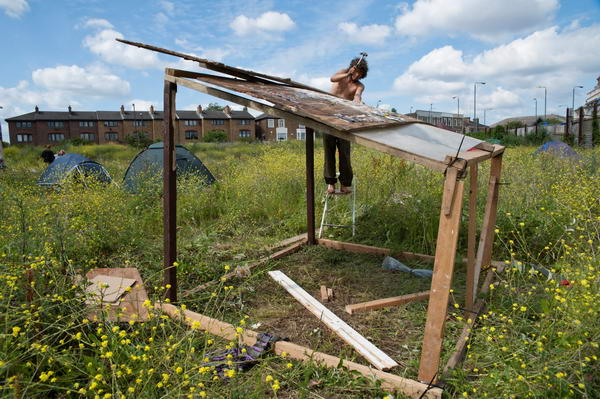
Construction work continues at Kew Eco-village
more pictures
On Saturday 6 June, a group of activists occupied a site next to Kew Bridge
that had been empty for more than 20 years, intending to develop it as a community
resource. The action was very much inspired by the 1996 'The Land is Ours'
action in Wandsworth, where a site owned by Guinness was occupied for five
and a half months before the eviction.
Land is a scarce resource, particularly in urban areas, and land rights campaigners
argue that it should be used for the good of all, not simply for the profits
of landowners. Local communities should have a much greater role in planning,
and where owners fail to live up to their obligations to use land responsibly
they should lose their rights. Legally UK local autorities have quite extensive
powers to "remedy the condition of land", including the issue of
notices under Section 215 of the Town and Country Planning Act, 1990 and compulsory
purchase, but seldom make use of them.
The site at Kew Bridge has been derelict for over 20 years, being simply
used by its owners as an appreciating asset as land prices have risen. LB
Hounslow has failed to take effective action. A year or two ago the current
owners submitted a very extensive mixed development for planning permission
which was rejected and are making a further submission which Hounslow are
in process of approving. It seems astonishing that while the rejected proposal
included affordable housing, there is none at all in the latest proposal.
However the current fall in housing prices probably made any imminent development
unlikely even if permission i
The site appears to have been left to grow wild by its owners, with some
dumping of materials in parts of it. The large fence around its perimeter
creates an empty eyesore in an extremely desirable and visible riverside site,
next to Kew Bridge, part of London's South Circular Road. The site is also
a few yards from a railway station and on several bus routes, and not far
from the Great West Road and M4.
The occupiers intend to use the site productively, growing vegetables and
providing workshops and meeting spaces for the local community. Local people
have brought materials for building and plants and helped in clearing the
site and constructing some simple buildings on it. The site welcomes visitors
warmly but wants to be a good neighbour and has banned amplified music and
enforces a strict policy against alcohol or drugs on the site.
Last weekend the Eco Village/Brentford Community Garden had a solstice open
weekend with activities including face painting, music, picnic area and children’s
workshops, and I dropped in at the end of the day to take some pictures. Already
the site has been considerably improved.
more pictures
Albert Memorial
Kensington, London, Sun 21 June, 2009
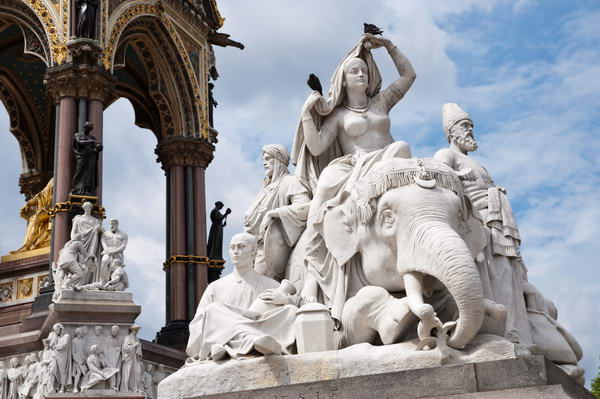
Colonialist exuberance in the Asia group at the northe-east corner of the
Albert memorial
more pictures
Although I'd have been with the Irish in refusing to contribute to the Albert
Memorial, there is a certain exuberance in its incredible profusion that is
sometimes hard to refuse, I'd actua0lly gone to photograph a musical event
on Exhibition Road, but I couldn't see anything worth photographing, and the
demo at the Iranian embassy around the corner obviously wasn't going to kick
off until considerably later, so I took a bus to Hammersmith rather than hang
around.
more pictures
800 Saxophonists- Leviathan
City of London, London Bridge. Sun 21 June, 2009
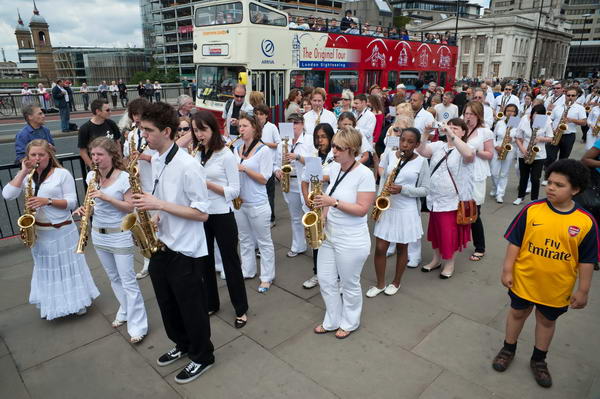
I couldn't see all 800, but there were certainly a lot.
more pictures
The Romans built a wooden bridge across the Thames somewhere close to the
present London Bridge and it lasted a few hundred years. Further wooden bridges
in Saxon times are mainly recorded when they burnt down either by accident
or invaders, or got swept away in floods.
Finally it was decided that a stone might be a better bet, and in 1176, Peter,
chaplain of one of the many city churches, started to build the first stone
London Bridge. He must have been a slow builder, as today's event on Midsummer
Day, 21 June 2009, marked the 80th anniversary of the bridge. Peter’s
bridge, despite a number of problems and with the aid of considerable rebuilding,
lasted for over 600 years, being replaced by the Rennie bridge, shipped to
the Arizona desert when it in turn was replaced by the current structure in
1967-72.
The anniversary was marked with a truly unique performance. Four groups,
each of roughly 200 volunteer saxophonists - "Any saxophonist can take
part, regardless of age or ability, all you need is a saxophone" - queued
to book in at four City locations - Ludgate, Aldgate, Moorgate and Bishopsgate
and at noon made their way through the ‘square mile’ to London
Bridge, each playing a part of 'Leviathan', a specially commissioned work
written for the City of London Sustain! Festival by John Harle.
On reaching London Bridge each player moved on to a second part of the composition
as the passed a marker (perhaps confusingly a large number 1.) Close to the
centre of the modern bridge, a few yards west of the original, whose roadway
passed through the porch of the church of St Magnus the Martyr - was a small
temporary podium from which composer John Harle conducted the ensemble in
the final section of the work.
The 800 players then completed the crossing, still playing until they reached
the Southwark end of the bridge, where they stopped around the Southwark 'Spike'
and were rewarded with a free sandwich.
more pictures
March for Imprisoned Tamils
Hyde Park to Temple, London . Sat June 20, 2009
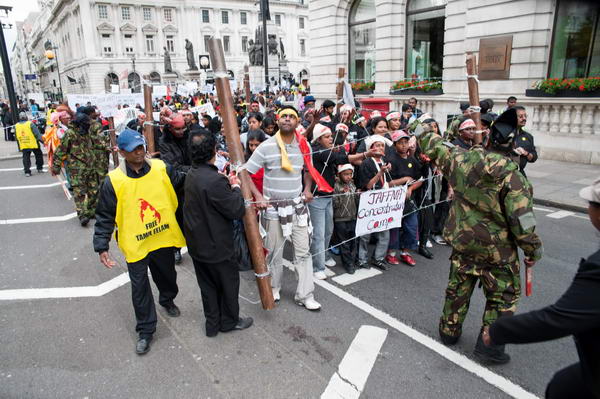
The 'concentration camp' at the front of the march in Pall Mall
more pictures
It was certainly a large and impressive march, led by a 'barbed wire' square
of people held by prison guards representing the internment camps in Sri Lanka
where around 300,000 Tamils are imprisoned under appalling conditions after
the military defeat of the LTTE (Tamil Tigers.) The BBC said there were 20,000
marchers, but the organisers figure of over 100,000 may be closer to the truth.
I don't have a real idea as I didn't stay long enough to see the end of the
march, but when I reached Trafalgar Square with its head, I overheard a police
message saying that demonstrators were still leaving Park Lane, about 2km
back.
Many of those taking part wore black, remembering 50,000 or more Tamils who
have been killed in the recent conflict. Some carried photographs of relatives
dead or disappeared - according to the UN Office for the Coordination of Humanitarian
Affairs in one week this month, "over 13,000 internally displaced people
disappeared from Sri Lanka’s internment camps for Tamil civilians".
The protesters handed in a letter at Downing Street calling for the immediate
release of all prisoners, for full access for humanitarian aid and for the
prosecution of the Sri Lankan President, Defence Minister and Army Chief for
war crimes.
They also continue to demand a separate Tamil Homeland, Tamil Eelam, in Sri
Lanka, and many carried the Tamil Eelam national flag which uses the LTTE
tiger symbol. Tamils very much feel that they have been let down by the UN,
the international community in general and Britain in particular as the ex-colonial
power, and seem justified in doing so. The march ended with a rally which
I didn't attend.
more pictures
Still Human - Still Here
Cleopatra's Needle - Trafalgar Square, London. Sat June 20, 2009
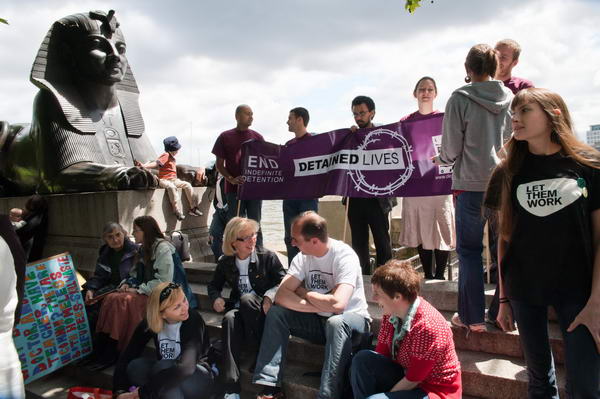
Waiting for the march at Cleopatra's Needle
more pictures
As a part of Refugee Week, London Amnesty Local Groups and others including
the Refugee Council organised a march starting at Cleopatra's Needle on the
Embankment to a rally in Trafalgar Square. As well as marchers with placards
and banners, there were a number of large puppets depicting refugees from
different countries.
The UK's treatment of asylum seekers is often inhumane and seems driven more
by a desire to look tough on immigration than on any sensible response to
the problem. A report by the Independent Asylum Commission last year stated
that our treatment of asylum seekers "falls seriously below the standards
of civilised society". In particular, as many including MP Iain
Duncan Smith have commented, "the policy of making asylum seekers
destitute is mean and nasty and has not worked."
Many of those who come here have skills which would contribute to our society
- and are keen to do so. Detaining them in immigration prisons when they have
committed no crime is costly and inhumane. Allowing them to work would help
them and us, as well as reducing the burden of public expenditure.
more pictures
Gordon Brown Dismembered at New Labour HQ
Victoria St, Westminster, London. Thursday 18 May, 2009
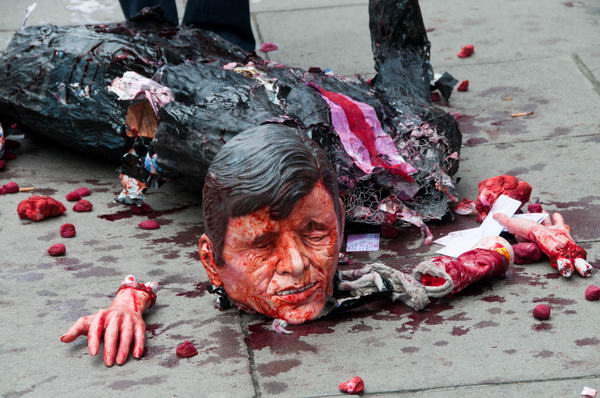
Blood and guts on the pavement outside the Labour Party offices
more pictures
Chris Knight and 'The Government of the Dead' came to the
offices of New Labour on Victoria Street, close to the Houses of Parliament,
bringing with them a life-size dummy of Gordon Brown. They called for the
government to go, and for the Labour Party to return to socialist values,
starting with the re-adoption of Clause 4:
"To secure for the workers by hand or by brain the full fruits
of their industry and the most equitable distribution thereof that may be
possible upon the basis of the common ownership of the means of production,
distribution and exchange, and the best obtainable system of popular administration
and control of each industry or service."
Knight had a simple solution for a current problem: "No Redundancies
- we'll nationalize the Lot!"
Soon blood was covering the pavement as Brown's head and arms were ripped
off, and the zombies began trying to eat his body parts. A PCSO came and asked
them not to be there too long and make sure they tidy up afterwards. Treating
street theatre as a 'media event' rather than a demonstration avoids
a lot of police paperwork.
Membership cards for the real The Labour Party were handed out, signed by
the new General Secretary, Chris Knight, who led the small assembled crowd
in 'The Red Flag’, and unlike most delegates to the annual party congress
he actually knew the words.
The meeting was also addressed the Political Commissar for Zombie Wrangling
of the Government of the Dead, one V I Lenin, who carried a
poster misquoting himself from 1918, "I want to support the 'New'
Labour Party in the same way as the rope supports the hanged man",
complete with a small gibbet and hanging skeleton for the benefit of photographers
and the illiterate.
The event was also watched by a couple of rather low-key security men from
the New Labour offices, one taking photos. The only slight unpleasantness
was when a man employed in the Labour offices barged angrily through the people
standing around watching, and then turned round to threaten a photographer
who had protested at being pushed. The security men quickly persuaded him
to leave and go inside the building. From his attitude I thought he might
be from the No 10 Press Office, but his language was insufficiently colourful.
more pictures
Ravidassia March against Caste Discrimination
Marble Arch to India House, London. Sunday 14 June, 2009
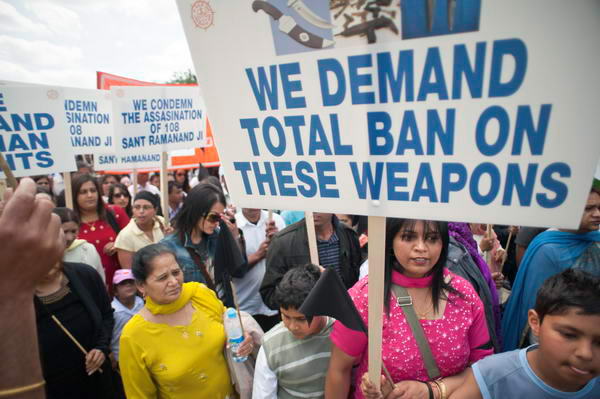 Ravidassias
protest agasint caste dicrimination and the assassination of Sant Ramanand
in Austria last month
Ravidassias
protest agasint caste dicrimination and the assassination of Sant Ramanand
in Austria last month
One thing that many Sikhs and Ravidassia seem to be agreed on is that the
Ravidassia are not Sikhs. Doubtless the BBC got many complaints after it called
Sunday's march from Marble Arch to India House a Sikh march, as I did for
calling Ravidassia a Sikh sect - just as every other newspaper article on
the events that led to the march has done. Currently the 175,000 or so in
the UK Ravidassia community are included in our population statistics as Sikhs,
but many of them hope to be listed as a separate religion in the 2011 census.
I've already stirred up controversy by writing about this demonstration elsewhere,
and have no wish to add to this.
On 24th May, a small group of Sikhs interupted the ceremonies in the Sri
Guru Ravidass Temple in Vienna, Austria by shooting the two visiting preachers,
leaders of Dera Sach Khand, based at Jalandhar in India. One of the men, Sant
Ramanand, died later that evening, and the killing led to violent protests
in India, particularly around Jalandhar, in which a number of people were
killed and injured in battles between protesters and police.
Sikhs accuse the followers of Ravidass of disrespecting the Guru Granth Sahib,
the Sikh scriptures which Ravidassia also claim they regard as holy. Shri
Guru Ravidas Ji was one of a number of holy men whose work was incorporated
into the Guru Granth Sahib, along with the writings of six of the Sikh Gurus.
He came from a low caste and was one of the first to stand up for equal rights
for all people regardless of caste - something which became central to Sikhism.
The several thousand from the Ravidassia Community around the UK (and a group
from France) who marched through central London today to the Indian High Commission,
see the continuing caste-based discrimination against them as the cause of
the assassination. Their placards called for 'Human Rights', 'Freedom of Speech'
and 'Justice', condemned the assassination of Sant Ramanand, called for the
murderers to be hanged and demanded equal rights to worship.
The police stopped traffic for the march and encouraged them to keep moving.
One man who was handing out leaflets to marchers was led away for questioning
and presumably searched at the roadside.
more pictures
World Naked Bike Ride - London
Hyde Park, Waterloo, St Giles, Oxford St London. Sat June 13 2009
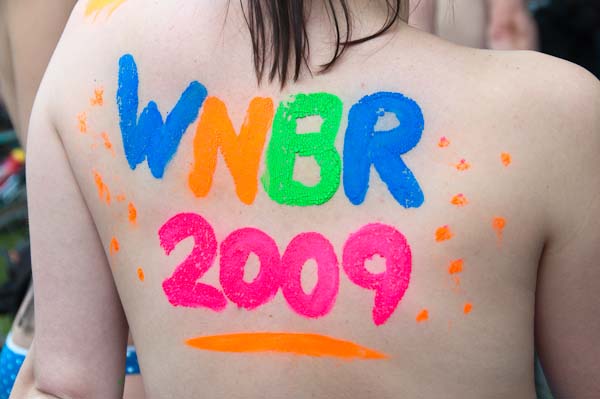
Warning: these pictures show men and women with no clothes
on. Do not click this link to more pictures if
pictures of the naked human body may offend you.
I don't have a problem with nudity, nor apparently do the Metropolitan Police,
who allowed this 10km cycle ride by around 1200 mainly naked people to go
around the crowded tourist areas of London's West End, and, also on pedal
cycles but fully dressed, accompanied the cyclists and eased their passage
through the traffic. So far as I could see the ride caused no offence to those
who stopped to watch it, though consderable hilarity and a certain amazement.
However many obviously remained uncertain about the purpose of the event.
Some riders did have slogans on their bodies, mainly about oil and traffic,
and some bikes carried A4 posters reading REAL RIGHTS FOR BIKE and CELEBRATE
BODY FREEDOM or had flags stating 'CURB CAR CULTURE' which made clear the
purpose of the event to the careful onlooker, but for most people it seemed
simply a spectacle of naked or near-naked bodies. Though of course also a
rare treat for any bicycle spotters among them.
Riders rode in a variety of dress and undress. Apart from shoes - virtually
essential on a bike - some wore nothing, while others added body paint, cycle
helmets, hats, shorts or briefs, bras and often a camera; a few rode fully
dressed. As on previous events there were considerably more men than women,
something that isn't fully reflected in my pictures. Although there were fewer
women, more of them were in colourful body paint or otherwise stood out from
the crowd.
For most of those taking part it was a fun event as well as a demonstration,
and most waved and smiled at me as I took pictures - including quite a few
who know me, though it was sometimes difficult for me to recognise them. As
well as my pictures here, there were around 700 from the ride in the Flickr
London Naked Bike Ride Pool when I checked. But at least half the riders seemed
to be taking pictures as well as almost all of the thousands who watched the
event.
Warning: these pictures show men and women with no
clothes on. Do not click this link to more pictures
if pictures of the naked human body may offend you.
Speak out against Racism and Deportations
Angel, Islington, London. Saturday 13 June 2009
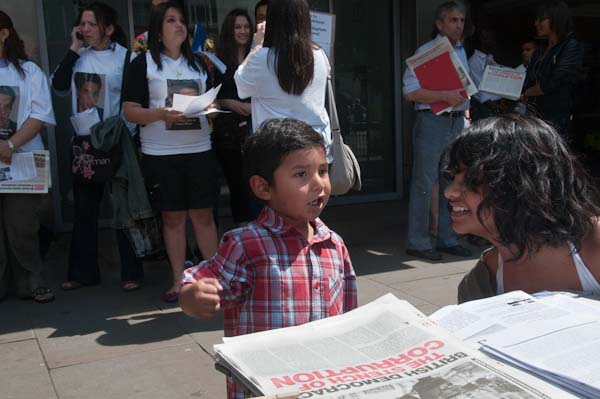
There were two stalls with literature. In the background,
the Suarez family hand out leaflets
more pictures
Around 70 people protested againt the UK's inhumane and racist immigration
laws outside the Angel tube in London on Saturday afternoon, 13 June, 2009.
The current government has taken a lead in the forced deportation of asylum
seekers and others without documentation, often denying them any legal representation
or proper appeal. Many who speak English only poorly or not at all are questioned
and detained without an interpreter.
Detention centres have been condemned by many, including official inspectors,
and the conditions there and lack of access to legal advice show a clear and
institutional contempt for human rights. And although the government will
not deport people to some countries because of the threat to their lives,
there are too many cases were people who have been returned are subjected
to imprisonment and torture.
Among those present at the 'Speak Out' were members of the Suarez family,
who prevented the deportation of John Freddy Suarez Santander last month by
going together to the airport to stop it. John Freddy came to the UK from
Colombia with his family when he was six, 15 years ago, and grew up here -
he now has a 3 year old son. All his family now live in Europe and he has
no relatives back in Colombia. But five years ago he committed an offence
and waas sent to a young offenders institution for 7 months. Two years after
he had served his sentence, the UK government passed a law to deport all immigrants
with a criminal record, and an order was made for him to be sent back to Colombia.
John Freddy's case has now reached the European Court of Human Rights, and
a decision is awaited, but the government tried to prempt this by deporting
him. The UK law seems to go against the principles that people whould not
be pubished twice for the same act and that laws chould not be applied in
a retroactive manner, as well as the European court assertion that juvenile
offences should not be seen as a part of a criminal record.
Other speakers at an open mike included a Bolivian activist, who is currently
on bail, having been detained in the Yarls Wood Immigration Detention centre,
who was able to speak at first hand about the rotten conditions there, particularly
over the detention of children. There were speakers from 'No Borders' groups
in Canada and London and other groups campaigning for justice for migrants,
as well as speakers about the racist nature of the press, the activities of
multi-national corporations - particularly in Nigeria, where Ken Saro Wiwa
who had campaigned against Shell was murdered.
We were reminded also of the role of Cuba inspiring development in Latin
America by a speaker from 'Rock around the Blockade', and of the Miami 5,
still held in US prisons.
During the time I was there, a steady stream of people came past the 'Speak
Out' and quite a few took leaflets and stayed for at least a few minutes to
listen, with some looking at the material on the stalls or signing the petition.
Unfortunately I was unable to stay for the entire protest, and so missed
the street theatre and some of the speeches. But the most moving came from
Christina, a young woman whose husband is in Campsfield Detention Centre,
who broke down in tears as she told us of the effect his deportation would
have on her young family. It was a very human moment that cut through the
politics to what really matters, and that made me angry and ashamed at the
actions of a Labour government and the Borders Agency.
more pictures
Carshalton Carnival Procession
St Helier - Carshalton, London. Saturday 13 June, 2009
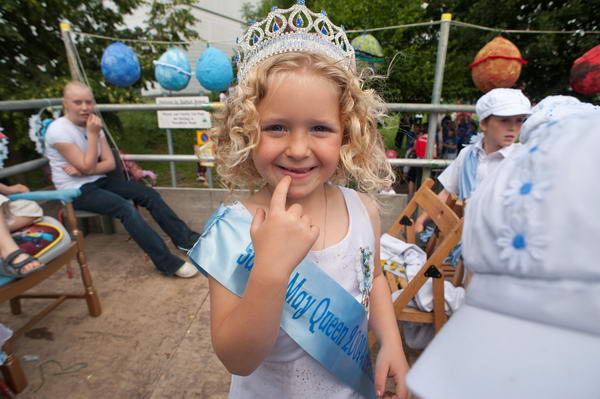 Sutton
May Queen 2009 come to look at my cameras
Sutton
May Queen 2009 come to look at my cameras
more pictures
The Carshalton Carnival procession began at the centre of the St
Helier estate, a huge sprawling area built by the LCC 1930 to a kind of debased
Garden City plan almost entirely without the charm of those earlier developments
on what had previously mainly been the lavender fields of Mitcham.
At its centre is the St Helier Hospital in the modern style of the 30s, facing
the imaginatively named St Helier Open Space, and the carnival procession
formed up along the road along one side of this, now partly occupied by Sutton
Arena leisure centre.
I'd gone to photograph the event partly because some May Queen groups were
taking part and it seemed a useful additionl to my project on these groups.
Three of them, Sutton, Beddington and Wallington were there, but Wallington
came dressed as aliens or space women, and on top of a high sided lorry. Fun
for them but with few opportunities for photography. It was even hard to read
the sign on the back which said:
A
Walling
tonmay queen5!!
2009!
It did have a crown above it which was perhaps a clue. The carnival theme
was "planets and stars" as 2009 is the UN International Year of
Astronomy. According to the local Guardian newspaper, it was 400 years ago
this year that "Galileo first glimpsed the Moon", but I
think we can be pretty sure that others had noticed it well before him.
It's a long walk from St Helier to the park in the centre of Carshalton where
the carnival takes place, and the procession halts for a rest (and a slow
queue for the toilets) at Carshalton college before proceeding there, and
I left it to walk down to the station and a train back to town.
more pictures
25 Years and Still No Justice for Sikhs
Hyde Park - Trafalgar Square, London. Sunday 7 June, 2009
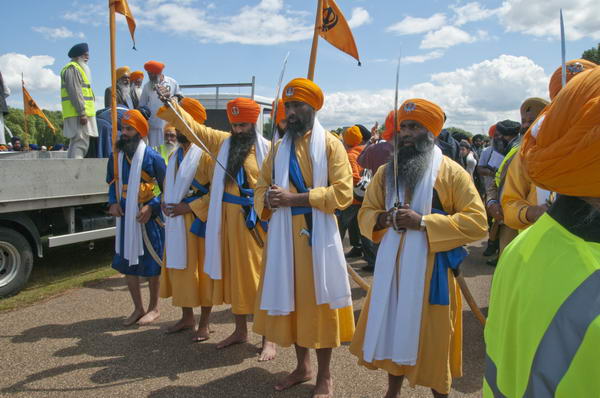
Sikhs draw swords to lead the march to Trafalgar Square
more pictures
Never Forget 84 was the slogan on many of the t-shirts and posters,
while other placards spelled out in detail and graphic pictures some of the
atrocities committed by Indian forces and Hindu mobs against Sikhs in 1984.
Operation Blue Star, in June 1984, when the Indian Army attacked the Golden
Temple at Amritsar to detain Sikhs who were fighting for an independent Sikh
state of Khalistan, destroyed much of the temple and, according to independent
accounts, killed around 5000 Sikhs, many of them women and children (Sikh
sources put the figure around twice as high.)
Indian Prime Minister Indira Ghandi was blamed for the attack, and
in October 2004 she was assassinated by two Sikhs serving as her bodyguards.
Following this, there was widespread mob violence against Sikhs, particularly
around Delhi, incited by prominent members of the Congress party, with police
often giving their active support, and thousands were massacred.
Both the fight for Khalistan and the persecution of Sikhs have continued,
although attracting little news coverage in the outside world. Sikhs claim
that over 250,000 Sikhs have been killed by in an orchestrated genocide by
the Indian government.
The largest of the Sikh separatist groups is Babbar Khalsa International,
founded by Sukhdev Singh Babbar (1955-92) and one of 45 groups from
around the world proscribed by the UK government by the Terrorism Act 2000
(the 45 include another Sikh group, the International Sikh Youth Federation.)
One of the best-known Babbar freedom fighters is Jagtar Singh Hawara,
who escaped from a maximum security jail in 2004 with two other Sikh militants.
Sunday's demonstration started with a rally in Hyde Park, with speakers calling
for an independent Khalistan. Police made an attempt to ban some of the placards
carried by marchers, with Superintendent Kohli, the officer in charge,
objecting particularly to placards which named some prominent Indian politicians
and had an image of an anonymous head in a gun-sight (presumably seeing them
as an incitement to violence) while Constable Lockwood objected to some photographs
of massacre victims as being unsuitable as they might be viewed by children.
Kohli was also carrying an A4 sheet with the Babbar symbol on it, which was
so widespread among the placards and some banners at the event that he presumably
felt it impossible to take action against. I saw no arrests being made or
individuals on the march being warned for carrying pictures of Babbar or Hawara
with the Babbar symbol. Although some kind of agreement was apparently reached
between police and marchers, many if not all of the placards they had objected
to were also being carried.
While objections made under the Terrorism Act 2000 relating to proscribed
organisations would appear to be a clear, the objections raised about the
content of some of the photographs (possibly under Section 5 of the Public
Order Act) seem considerably more controversial, and very much an attempt
by the police themselves to act as censors rather than to respond to any public
complaints. It seemed very much to be an attack on free expression and would
seem to be liable to challenge as an attack on human rights.
The Terrorism Act proscribed a number of organisations that to the communities
concerned seem to represent their legitimate aspirations for self-determination.
At times these decisions seem to have been based on a narrowly seen US interest
and a political need by the US and its allies in the so-called ‘war
on terror’ to keep governments facing struggles for liberation on the
US side.
At the front of the march were five Sikhs dressed in orange, with swords
held up, walking barefoot (the Panj Piare), followed by a group of
Sikh leaders, and then rows of mainly young people with tall black poles bearing
black flags, followed by 16 black coffins. Behind them was a long and fairly
tightly packed march with perhaps 20,000 Sikhs, many carrying banners and
placards including those that the police had objected to.
This was the 25th anniversary of the 1984 massacres, and feelings seemed
to be running even higher than in previous years, with much more widespread
support for Babbar. The march was to a rally in Trafalgar Square but I left
it before it reached there.
more pictures
A Little History - Pure Genius 1996
Wandsworth, London. Monday May 6, 1996
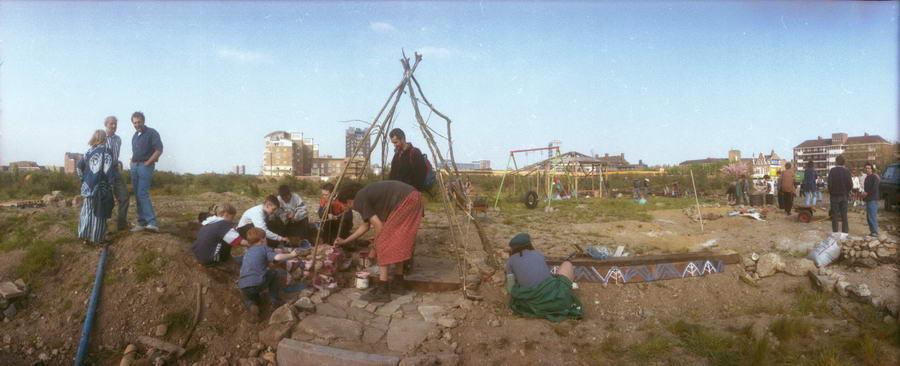
Pure Genius at Battersea in 1996
more pictures
Yesterday a group of activists occupied a site next to Kew Bridge that had
been empty for more than 20 years, intending to develop it as a community
resource. The action was very much inspired by the 1996 'The Land is Ours'
action in Wandsworth, where a site owned by Guinness was occupied for several
months before the eviction. I went to photograph the site in May 1996, using
a panoramic camera and colour negative film. I thought it might be interesting
to see those pictures again, and here are some very quick flatbed scans, with
apologies for the odd colour, marks and defects. Later I'll scan some of these
properly.
more pictures
Bridget Cherry - Poplar Trail
Poplar, London. Sat 6 June, 2009
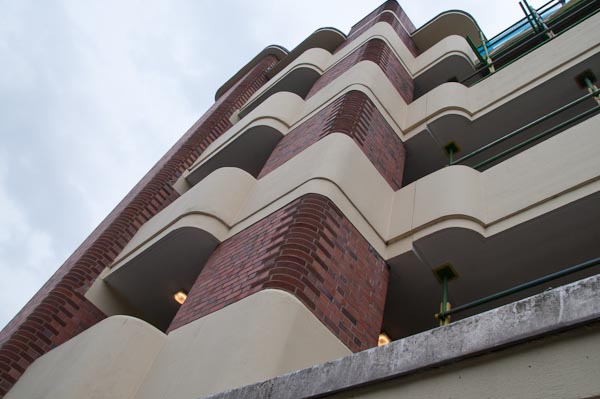
Constant House, 30s flats, refurbished since I photographed it in the 90s
more pictures
The Story of London Festival throughout June includes many events
celebrating the captial, and this first weekend was designated the Walking
Weekend. I went to a couple of free events put on by the Heritage
of London Trust & Pevsner Architectural
Guides in east London, as well as doing a little on my own.
Saturday morning was a guided tour by Tara Draper-Stumm around of
one of East London's more fascinating churches at East Ham, well worth a visit
for both the building and the monuments it contains, and including some items
from the abbey around which Stratford was founded, long demolished. The church
was once seriously considered as a cathedral for Essex. Interesting though
it was I didn't feel moved to add to the many pictures taken in churches which
certainly used to make up the bulk of our national photographic collection
and I imagine still do.
I had my lunch while taking another trip to Stratford Marsh - see below -
and then took the DLR from Pudding Mill Lane to Poplar for the second walk,
led by someone whose name has been familiar for many years but I'd not before
met, Bridget Cherry, a leading architectural hisotrian whose name
appears on the essential works for anyone with an interest in the subject,
The Buildings of England, begun by Nikolaus Pevsner in 1951. She
worked on many volumes as well as becoming General Editor.
Many times I've followed the "perambulations" from various volumes
of Pevsner, including the five and a half London volumes around my desk and
those for other areas I've borrowed from libraries, and I was delighted to
have the chance to be taken on one by her in person. I've walked round Poplar
a few times before - like most areas of London - and photographed the buildings
that interested me, but it was good to be made to look at some of the others
as well - and to have them put into context.
Among the more interesting buildings we looked at was Robin Hood Gardens,
built 1966-71 to the designs of Alison and Peter Smithson, and in many respects
a fine solution to a difficult site with some superb landscaping in the large
interior space. Deliberately encouraged to ruin by overcrowding and use as
a sink estate by Tower Hamlets, it is now in a sorry state, but the decision
not to list it is unfathomable (or perhaps simply political.) I hope the campaign
to save it from demolition succeeds.
We finished our walk at St Mathias Old Church, unusually built in
the 1650s, though encased in a Victorian Gothic shell. Now a community centre,
its interior has been carefully restored, and gives some idea of its original
appearance, complete with seven of its eight columns made from English oak,
said to be from ships of the East India Company with which it was closely
connected. The tea and biscuits there were very welcome!
Though you've missed the walks you can still download the illustrated guides
to them from the Heritage
of London Trust site, where you will also find how to become a Friend
of the trust and get invitations to regular lectures and visits.
more pictures
Olympic Update
Stratford Marsh, London. Sat 6 June, 2009
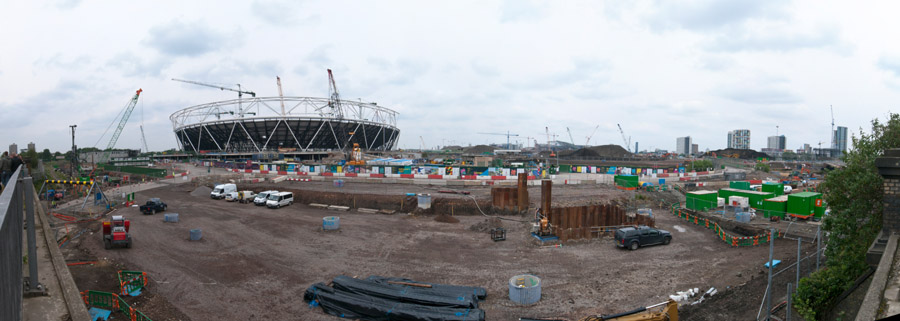
Mercator projection from the Greenway
more pictures
Another of my roughly monthly visits to the Northern Outfall Sewer to photograph
the developing Olympic site. Several different panoramas this time, and also
non-panoramic pictures of the stadium and other works.
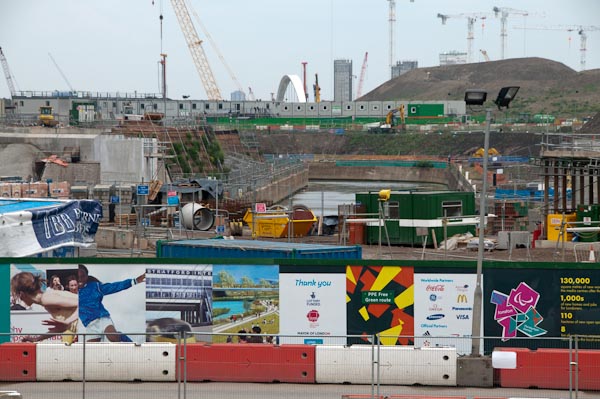 City
Mill River is still just visible, but the Pudding Mill River has disappeared
completely in the top picture
City
Mill River is still just visible, but the Pudding Mill River has disappeared
completely in the top picture
more pictures
Pedal Power Bike Rush
Westminster, London. Monday 1 June. 2009
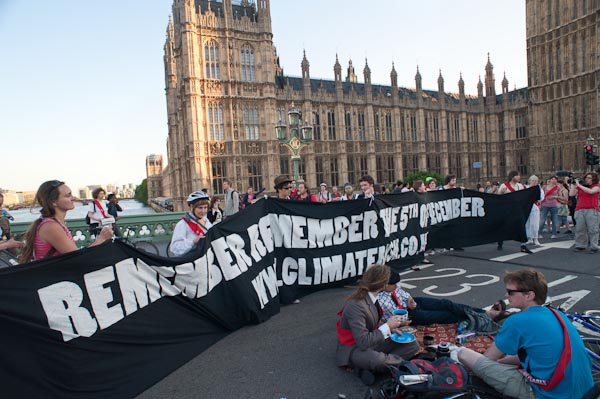 Remember,
Remember the 5th of December - the National Climate March before Copenhagen
Talks.
Remember,
Remember the 5th of December - the National Climate March before Copenhagen
Talks.
more pictures
Several hundred climate change activists took part in the
Pedal Power Bike
Rush, a mass bicycle ride organised by the '
Climate Rush' around
London demanding the UK government take effective action to counter climate
change and global warning.
'Climate Rush' is a direct action group led and inspired by women, modelled
on the Suffragette Movement of a hundred years ago and earlier in the day
they had staged a protest outside Chatham House in St James Square where the
conference, 'Coal: An answer to our energy security’ was taking
place, attempting to block the entrance with a sculpture made of bikes. With
a banner ‘NO NEW COAL – CLIMATE RUSH’, and they demanded
that no new coal-fired power stations should be built unless and until the
industry can demonstrate it can capture and store all of the huge amounts
of carbon produced by them. The protesters were forcibly removed by police
and five were arrested.
The 'Bike Rush' gathered at the same place around 5 pm, with almost 300 cyclists
and a tandem-hauled sound system moving off at 18.10 for a tour of the main
streets of the West End including Piccadilly Circus, Shaftesbury Avenue, Oxford
St, Regent St, St James St and The Mall, passing Buckingham Palace and then
cycling around Victoria before heading to the Houses of Parliament and Westminster
Bridge.
Some of the protesters rode in white dresses and hats evoking the Suffragette
era, and one came in black as a widow, mourning the end of coal. Many more
wore sashes, copying from the purple sashes worn by the Suffragettes, but
in 'Climate Code Red'. Some had this extreme security message, while
others bore the suffragette motto, 'Deeds Not Words' or specific
slogans including 'No Airport Expansion', 'Action on Coal Now!,
'Trains Not Planes' and 'Pedal Power.'
Several cycle rickshaws took part, as well a live band from Hare Krishna
on two cycle trailers. Several people with video cameras were filming the
event from bike trailers, but I simply rode my Brompton, jumping off at times
to take pictures.
The sound-system, which led the ride, let the people know what the protest
was about as it went along the busy streets. Riders also slowed to hand out
copies of 'Here Comes the Sun', a newspaper with information about
climate change and what people can do as well as celebrity exclusives from
Quentin Tarantino, Paris Hilton, Colin Firth, Vivienne Westwood, Daisy
Lowe, Stephen Hawking, Giles Deacon, Gavin Turk, Katherine Hamnett and
Queens of Noize, quotations from Gandhi, Einstein and more.
Police on pedal bikes rode with the protesters, stopping the traffic at some
junctions so the Rush could safely and legally go through red lights, and
at several points there were a couple of police Forward Intelligence Teams
(FIT) beavering away as usual behind their long-lens cameras and video, collecting
thousands of images of protesters and journalists for the database they deny
having. There were also police vans and more police outside several places
occupied by 'climate criminals', including the government’s clumsily-named
Department for Business Enterprise & Regulatory Reform (BERR),
responsible for promoting much of its anti-environment climate warming activity.
The Rush halted outside several of these offices of companies they accuse
of criminal irresponsibility towards the environment, including BP in St James
Square, the British Airports Authority at Victoria, and BERR. At each stop
people came to the microphone to comment on the activities of these organisations
and others we had passed, explaining how these companies were harming our
environment.
After cycling around Parliament Square, and stopping to express support for
the Tamils on hunger strike there, the mass of cyclists came to a halt on
Westminster Bridge, and after a few minutes, decided to have their end of
ride picnic in the middle of it. They brought out a very long banner with
the text 'Remember Remember the 5th of December' - the date of the
next National Climate Demonstration, a few days before the Copenhagen Climate
Talks and a reference to the man often claimed as the only person to have
entered parliament with honest intentions - and hung it briefly from both
sides of the bridge as well as displaying it on the roadway.
Police quickly cleared the cyclists from the southbound carriageway, but
when I left around 15 minutes later the picnic was still continuing on the
northbound side of the bridge, and no traffic was moving across the bridge
in either direction.
more pictures
top of page
All pictures on this section of the site are Copyright ©
Peter Marshall 2009; to buy prints or for permission to reproduce pictures
or to comment on this site, or for any other questions, contact
me.








 The
Olympic stadium from Stratford town centre
The
Olympic stadium from Stratford town centre





 Ravidassias
protest agasint caste dicrimination and the assassination of Sant Ramanand
in Austria last month
Ravidassias
protest agasint caste dicrimination and the assassination of Sant Ramanand
in Austria last month






 City
Mill River is still just visible, but the Pudding Mill River has disappeared
completely in the top picture
City
Mill River is still just visible, but the Pudding Mill River has disappeared
completely in the top picture Remember,
Remember the 5th of December - the National Climate March before Copenhagen
Talks.
Remember,
Remember the 5th of December - the National Climate March before Copenhagen
Talks.